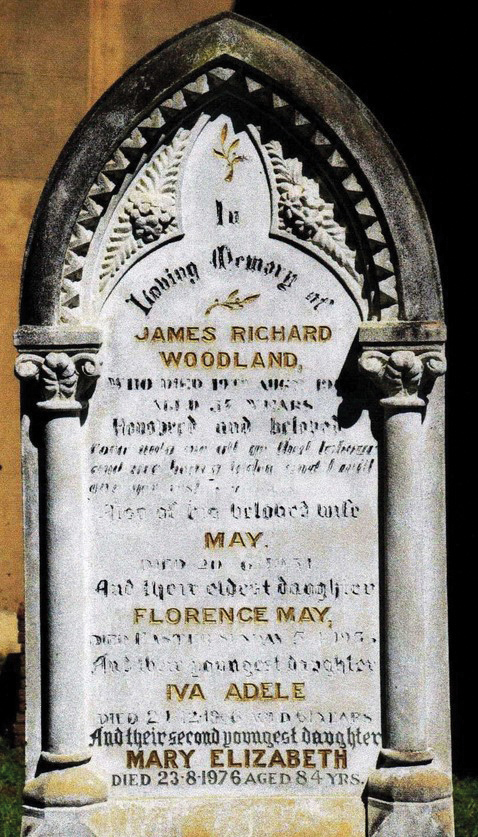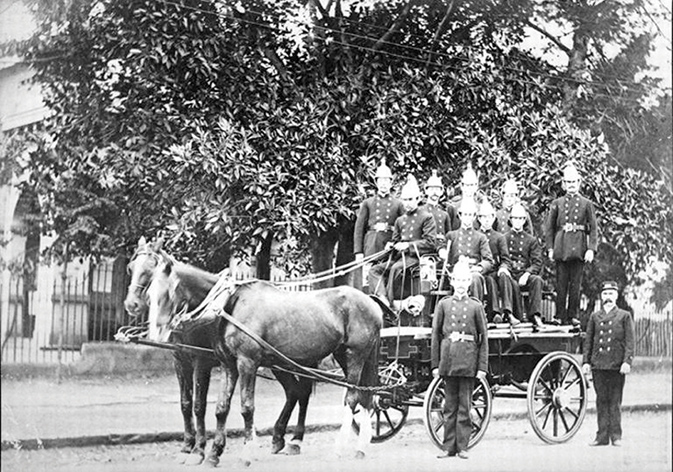Photo of the Woodland grave courtesy of Ancestry.
By Lyn Forde – President/Research Officer of St Marys & District Historical Society Inc.
IN January 1887 in the Nepean Times “Japonica” was reminiscing about the old once great homesteads going to “rack & ruin”. He wrote that the old homestead called “Dunheved” once the birthplace of John King Lethbridge whose parents were Robert Copland Lethbridge and Mary King. The building was being quickly transformed into a new building, with a charm about the old places, just the same as old faces that were familiar to him from his childhood and it was pleasant to see these old places taken care of. He said that “Mt Druitt House” was owned by Major George Druitt on 2,000 acres of land granted to him by Governor Macquarie that he named “Mount Druitt” and by 1887 the house was allowed to go into ruins and finally disappear. “Wallgrove House” originates from Lieutenant Colonel William Wall who was an army officer from Britain who retired in NSW. He purchased land along Eastern Creek in 1827 naming it the “Wallgrove Estate” (which later was the land outside of the Minchinbury Estate (Minchinbury Wines)) and it changed hands just in time to save it from ruin. “Shane’s Park House” located on the lands of the Dharug people was by 1887 uninhabitable and not repairable. The estate was granted to Surgeon John Harris in 1805. Although listed as 700 acres it did in fact consist of 785 acres. There are a couple of theories as to how John Harris settled on the name ‘Shanes Park’ for his residence and estate. Historic “Mamre House” at St Marys is included in important listings by the NSW National Trust. The typical two-storey Georgian farmhouse with verandas on three sides and built about 1830 for Reverend Samuel Marsden, the once favoured home of fruit and flowers. In use from 1804 – 2005 by Marsden Family, Charles Simeon Marsden, Richard Rouse, Elizabeth Howard Brabyn, John Panton, Sarah Brabyn, Elizabeth Rouse, Robert Fitzgerald MLC, Fitzgerald Family, James Hall, Shadlow Family, Samuel Barber Dale, Stonestreet Family, Ogilvie Family, George Walter Brangwin, Colin Maclaurin, Sisters Of Mercy. (“Japonica”) went on to say I now learn that William Beacroft who has resided in the Dunheved estate for nearly forty years, now has notice to remove. The new tenant for Dunheved House will require the whole estate. It is very trying to have to break up a home after almost a lifelong residence. “Shrivenham Homestead” of blue-blood fame. Sarah Brabyn repurchased 110 acres of the former ‘Mamre’ estate for her daughter and son-in-law (Elizabeth & Richard Rouse) and called it ‘Shrivenham’. After a short time at ‘Shrivenham’ Sarah eventually leased ‘Mamre’ and the family returned to live in the homestead but by 1887 it was the home of the thorn and thistle and generally neglected. Once where peaches and apples once grew par excellence now the wattle and weeds are now flowering. “Bayly Park House”. Nicholas Bayly was a soldier and the son of the original Nicholas Bayly of Plas Newydd of Anglesea in Wales and his wife Frances, née Nettlefold of Kent and also a nephew of Henry Paget-Bayly the 9th Baron Paget and 1st Earl of Uxbridge. The family influence helped Nicholas to receive a commission without payment as an Ensign in the NSW Corps in 1797. In 1799-1800 Nicholas received two land grants totaling 566 acres at Eastern Creek that has been fairly taken care of. “Fleurs”, the dearest old spot of them all. Built around 1810 for Nicholas Bayly with approximately 2,500 acres. It was then sold to Richard Jones, a merchant and pastoralist who was born in 1786 at Chirbury, West Shropshire, England. He was the son of Thomas Bowdler Jones a small landowner and brewer and his wife Elizabeth Ann (Philips). Richard was educated in London and chose a mercantile career as a clerk in a London business. He first arrived in NSW in 1809 in the “Mary Ann”. By May 1815 he was agent for Forbes & Co of Bombay importing spirits but by 1887. (“Japonica”) says the home is now only in work-day clothes, the house is not so bad but the outhouses and the once famous orchard and vineyards are gone. Ah! Let us take care of the old homesteads.
James Richard Woodland J.P. was born in St Marys in 1849 and died in 1906 and is buried at St Mary Magdalene cemetery, St Marys. He wrote for the Nepean Times for nearly 25 years under the nom de plume of “ Japonica.” Those articles were nearly all written from memory and his quotations, always accurate.
Sources Nepean Times, Geographical Names Register of NSW, Wikipedia, and family information on Ancestry online.






